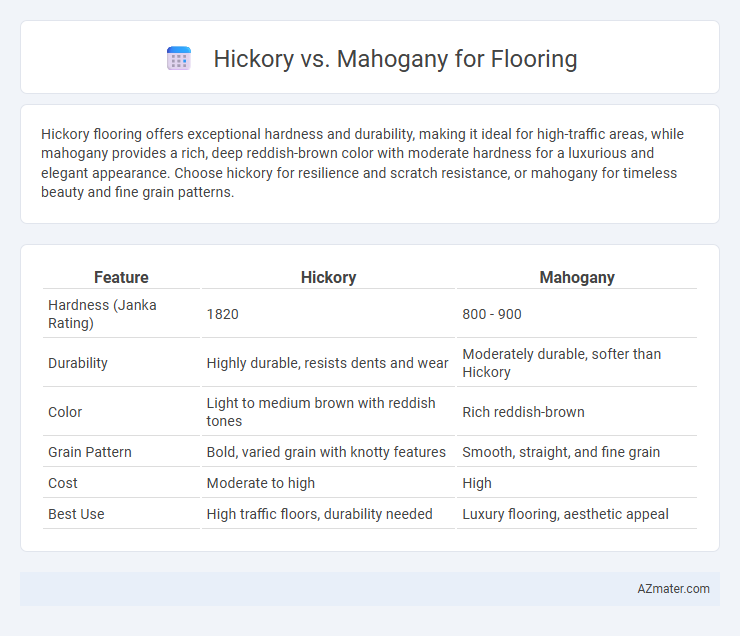Hickory flooring offers exceptional hardness and durability, making it ideal for high-traffic areas, while mahogany provides a rich, deep reddish-brown color with moderate hardness for a luxurious and elegant appearance. Choose hickory for resilience and scratch resistance, or mahogany for timeless beauty and fine grain patterns.
Table of Comparison
| Feature | Hickory | Mahogany |
|---|---|---|
| Hardness (Janka Rating) | 1820 | 800 - 900 |
| Durability | Highly durable, resists dents and wear | Moderately durable, softer than Hickory |
| Color | Light to medium brown with reddish tones | Rich reddish-brown |
| Grain Pattern | Bold, varied grain with knotty features | Smooth, straight, and fine grain |
| Cost | Moderate to high | High |
| Best Use | High traffic floors, durability needed | Luxury flooring, aesthetic appeal |
Introduction to Hickory and Mahogany Flooring
Hickory flooring is known for its exceptional hardness, durability, and distinctive grain patterns, making it ideal for high-traffic areas and rustic interior designs. Mahogany flooring offers a rich, deep reddish-brown color with a smooth, fine grain that enhances elegance and warmth in residential and commercial spaces. Both hardwood options provide unique aesthetic and performance qualities suited for different flooring preferences and environmental conditions.
Appearance and Color Variations
Hickory flooring is known for its dynamic appearance, featuring strong grain patterns and a wide range of color variations from creamy white to rich reddish-brown, offering a rustic and lively aesthetic. Mahogany flooring displays a smoother, more consistent grain with deep, rich reddish-brown hues that darken over time, providing a luxurious and elegant look. The distinct color variations of hickory create a bold, varied floor pattern, while mahogany's uniform tones contribute to a sophisticated and timeless ambiance.
Durability and Hardness Comparison
Hickory offers exceptional durability with a Janka hardness rating of approximately 1,820, making it one of the hardest domestic hardwoods ideal for high-traffic flooring areas. Mahogany, with a Janka hardness rating around 900 to 1,070 depending on the species, provides moderate hardness and durability but is softer and more prone to dents and scratches compared to hickory. These characteristics make hickory the preferred choice for flooring installations requiring superior resilience and longevity under heavy wear conditions.
Grain Patterns and Visual Appeal
Hickory flooring features pronounced, dramatic grain patterns with varied color tones ranging from light amber to reddish-brown, creating a rustic and dynamic visual appeal ideal for traditional or farmhouse-style interiors. Mahogany boasts fine, straight grain with a uniform texture and rich reddish-brown hues that deepen over time, offering an elegant and sophisticated aesthetic suitable for classic or formal spaces. Both hardwoods provide durable flooring options, but Hickory's bold, contrasting grains draw attention, while Mahogany's subtle, consistent pattern enhances warmth and luxury.
Installation Differences
Hickory flooring typically requires more precise acclimation due to its high hardness and moisture sensitivity, impacting installation time and techniques. Mahogany floors, being more stable and less prone to cupping, often allow for quicker installations with fewer adjustments. Both species benefit from professional milling and proper subfloor preparation, but Hickory's density demands stronger fasteners and more careful handling during nailing or gluing.
Maintenance and Care Requirements
Hickory flooring requires regular cleaning with a soft broom or vacuum and occasional damp mopping to prevent dirt buildup and maintain its natural hardness, while refinishing may be needed every 7-10 years due to its durability. Mahogany floors demand similar upkeep, including gentle sweeping and mopping with hardwood-friendly products, but they are more prone to scratches and may require more frequent polishing or refinishing to preserve their rich color and smooth finish. Both woods benefit from humidity control and protective pads on furniture to minimize wear and prolong floor life.
Cost and Budget Considerations
Hickory flooring typically costs between $5 and $9 per square foot, offering a budget-friendly option for durable hardwood floors. Mahogany, known for its rich color and luxurious appeal, ranges from $8 to $15 per square foot, representing a higher investment. Choosing between these woods depends on balancing initial expenditure with long-term value and aesthetic preference.
Environmental Impact and Sustainability
Hickory flooring is sourced from fast-growing trees abundant in North America, making it a more renewable option with a smaller carbon footprint compared to mahogany, which is often harvested from slower-growing tropical hardwoods that face deforestation challenges. The environmental impact of mahogany is typically higher due to illegal logging and habitat disruption in tropical regions, whereas hickory's sustainable harvesting practices and rapid regrowth contribute to better forest management. Choosing hickory aligns with eco-friendly flooring solutions by reducing deforestation risks and promoting sustainable forestry certifications such as FSC.
Best Applications and Room Suitability
Hickory flooring excels in high-traffic areas due to its exceptional hardness and durability, making it ideal for kitchens, entryways, and living rooms. Mahogany offers a rich, elegant aesthetic with superior stability and moisture resistance, suited for formal spaces such as dining rooms, studies, and bedrooms. Both hardwoods provide distinct grain patterns and color variations that enhance room ambiance depending on the desired design style.
Final Verdict: Which Wood is Right for Your Floor?
Hickory offers superior hardness and durability, making it ideal for high-traffic floors, while mahogany provides rich color and fine grain for elegant, less demanding areas. Consider hickory if you need a resilient surface resistant to dents and scratches, whereas mahogany suits homes prioritizing aesthetic warmth and luxury. The final choice depends on balancing durability requirements with desired floor appearance and maintenance level.

Infographic: Hickory vs Mahogany for Floor
 azmater.com
azmater.com